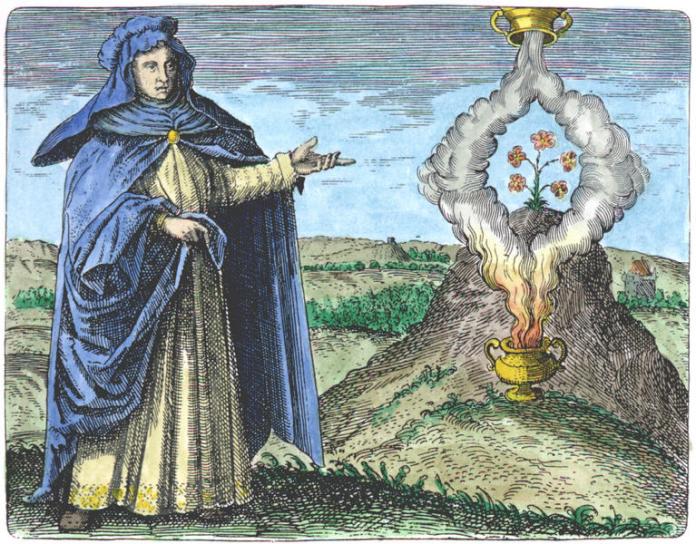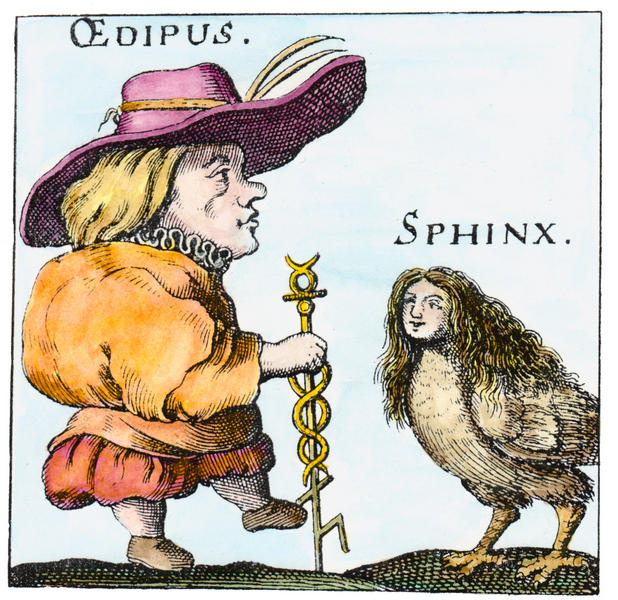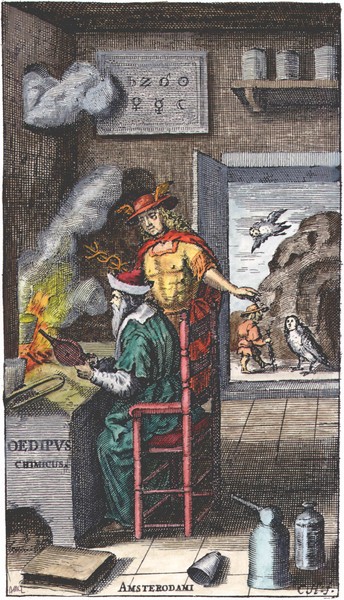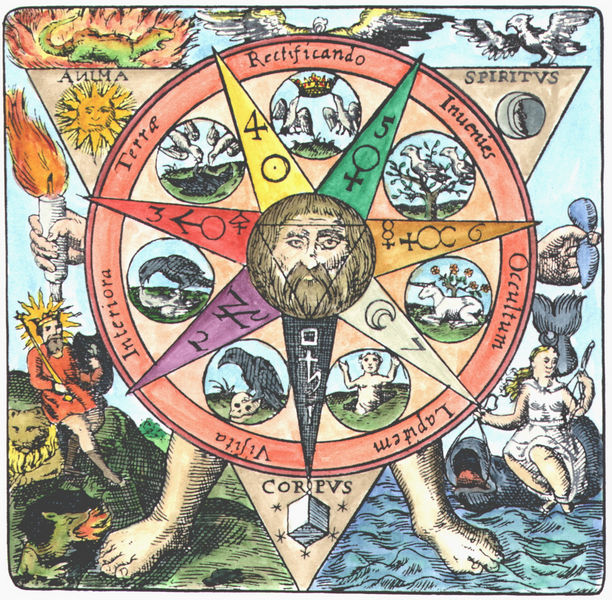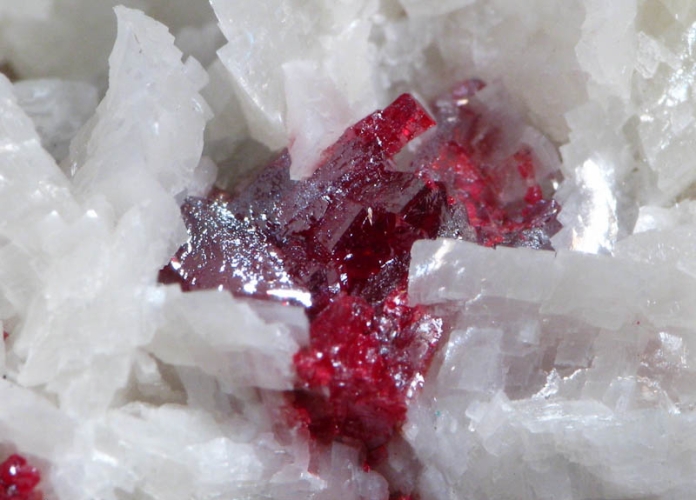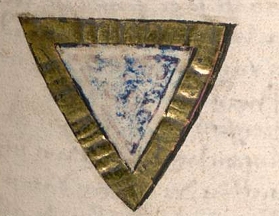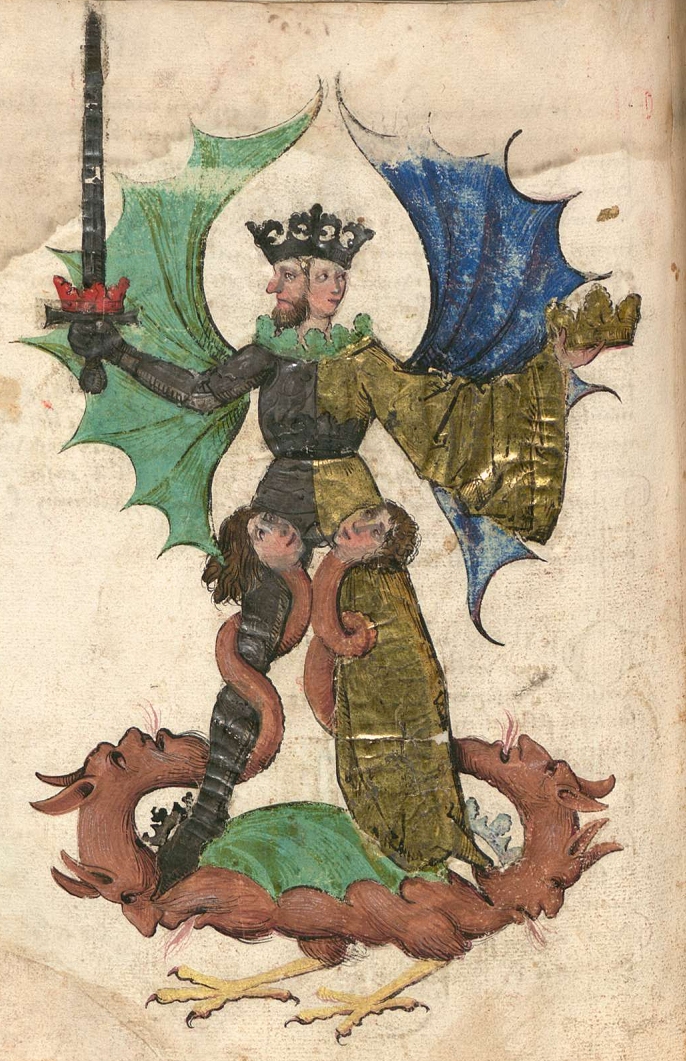The study of money, above all other fields in economics, is one in which complexity is used to disguise truth or to evade truth, not to reveal it.
John Kenneth Galbraith (1975) [1]
In our ancient past, we traded between ourselves simply by drawing on our public reputation. We did favours for each other, and memorised — later, recording on clay tokens — the I Owe You. Our “currency” was our public Honour.
Today, bankers use the magick of double-entry bookkeeping to create IOUs out of nothing. These digital ‘tokens’ represent our IOU to the bank. Then — by a clever accounting trick — they let us ‘borrow’ their IOUs as ‘money’. Why don’t we all do the same thing, and just lend to ourselves?
Colin McKay (2011) [2]

CONTENTS
- Misleading Parliament: Central Banks and New ‘Money’ Creation
- Seigniorage
- Usury – “Rose of Copper“
- deror – Imagine a world with no banks
Le bon Dieu est dans le détail (“the good God is in the detail”) means that attention paid to small things has big rewards.
MISLEADING PARLIAMENT
Imagine writing a paper for the Parliamentary Information and Research Service, correctly describing the Operational aspects of ‘money’ creation by the central Bank of Canada…
In practical terms, the Bank of Canada’s purchase of government securities at auction means that the Bank records the value of the securities as a new asset on its balance sheet, and it simultaneously records the proceeds of sale of the securities as a deposit in the Government of Canada’s account at the Bank – a liability on the Bank’s balance sheet (see Appendix A). No paper evidence of a bond, treasury bill or cash is exchanged between the Government of Canada and the Bank of Canada in these transactions. Rather, the transactions consist entirely of digital accounting entries. [..] By recording new and equal amounts on the asset and liability sides of its balance sheet, the Bank of Canada creates money through a few keystrokes.[3]
…but then showing the operation backwards:
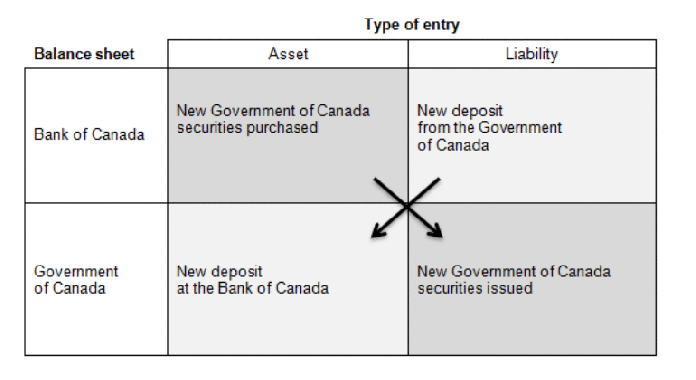
Source: Library of Parliament, Canada

Step-by-Step: How It *Really* Works
Imagine describing and showing the identical (in law) process of ‘money’ creation by the Private Banking System, and getting that exactly backwards too:
Private commercial banks also create money – when they purchase newly issued government securities as primary dealers at auctions – by making digital accounting entries on their own balance sheets. The asset side is augmented to reflect the purchase of new securities, and the liability side is augmented to reflect a new deposit in the federal government’s account with the bank.
However, it is important to note that money is also created within the private banking system every time the banks extend a new loan, such as a home mortgage or a business loan. Whenever a bank makes a loan, it simultaneously creates a matching deposit in the borrower’s bank account, thereby creating new money (see Appendix B). Most of the money in the economy is, in fact, created within the private banking system.

Source: Library of Parliament, Canada

Step-by-Step: How It *Really* Works
The authors of How the Bank of Canada Creates Money for the Federal Government: Operational and Legal Aspects, succeeded in misleading Parliament:
A key similarity between money creation in the private banking system and money creation by the Bank of Canada is that both are realized through loans to the Government of Canada and, in the case of private banks, loans to the general public.
The legal reality is that banks do not lend money:
What they do when they make loans is to accept promissory notes in exchange for credits to the borrowers’ transaction accounts. Loans (assets) and deposits (liabilities) both rise by [the same amount].
Federal Reserve Bank of Chicago [4]
It is important to notice here that the “Loans (assets)” are not loans to the borrowers. The “assets” of the bank are the promissory notes (promises to pay) issued by the borrowers.
Homeowners usually think of their mortgage as an obligation to repay the money they borrowed to buy their residence. But actually, it’s a promissory note they also sign, as part of the financing process, that represents that promise to pay back the loan, along with the repayment terms.
Investopedia [5]
Banks ‘purchase’ promissory notes (“securities”) from the public, and from the Government. Then, they record – not their payment, but their promise to pay – as a ‘credit’ (i.e., a ‘deposit’) to a customer or Government account at the bank.
These ‘deposit’ accounts are recorded as a Liability on the bank’s Balance Sheet. This means that the bank has not paid. The bank still owes payment* to the customer. The so-called ‘deposit’ is fictitious.
(* Legal tender: cash notes and coins)

Stated another way, the bank ‘buys’ our IOU, and ‘pays’ for it with … its own IOU!
Incredibly, the bank then claims that its IOU to us (‘deposit’) is, simultaneously, our ‘credit’ (loan) to the bank.
As ‘depositors’, legally, we are “unsecured” creditors of the bank.[6]
In other words, the bank did not really give us ‘credit’; we gave our ‘credit’ to the bank … and that record is what we use as money.
We are paying the banks “interest” for the privilege of using our own money.
Why don’t we all just give our own ‘credit’ … to ourselves?
Read this, and think carefully on the clever words, “in effect”:
In today’s world of computerized financial transactions, the Federal Reserve Bank pays for the securities with an “electronic” check drawn on itself. [..] The Federal Reserve System has added .. securities to its assets, which it has paid for, in effect, by creating a liability on itself…
Federal Reserve Bank of Chicago [7]
(Keep that concept in mind. Drawing. A liability. On yourself. I will be showing you a revolutionary new accounting system, where everyone can do this. We could become our own central bankers, and begin to solve many global problems, sustainably.)

Source: kateraworth.com
There is no need to take my word for this.
Or, indeed, the word of the Federal Reserve Banks.
Professor Richard Werner D.Phil (Oxon) has published scientific evidence that it is true:
I produced the first empirical studies[8] to prove that in the five thousand year history of banking.
The law courts in various judgements have made it very clear, if you give your money to a bank – even though it’s called a ‘deposit’ – this money is simply a loan to the bank.
They invent fictitious customer deposits.
The banks create the money supply by inventing these claims on themselves, the fictitious deposits.
The modern banking system manufactures “money” out of nothing; and the process is, perhaps, the most astounding piece of “sleight of hand” that was ever invented. [..] Banks in fact are able to create (and cancel) modern “deposit money”, just as much as they were originally able to create, or call in, their own original forms of private notes. They can, in fact, inflate and deflate, i.e., mint, and un-mint the modern “ledger-entry” currency.
Major L.L.B. Angas (1937) [9]
SEIGNIORAGE
He was the last of the magicians, the last of the Babylonians and Sumerians, the last great mind which looked out on the visible and intellectual world with the same eyes as those who began to build our intellectual inheritance rather less than 10,000 years ago.
Why do I call him a magician? Because he looked on the whole universe and all that is in it as a riddle, as a secret which could be read by applying pure thought to certain evidence, certain mystic clues which God had laid about the world to allow a sort of philosopher’s treasure hunt to the esoteric brotherhood. He believed that these clues were to be found partly in the evidence of the heavens and in the constitution of elements .. but also partly in certain papers and traditions handed down by the brethren in an unbroken chain back to the original cryptic revelation in Babylonia.
John Maynard Keynes, Newton, the Man[10]
Early 13c., “of or pertaining to the head,” from Old French capital, from Latin capitalis “of the head,” hence “capital, chief, first,” from caput (genitive capitis) “head” (from PIE root *kaput- “head”).
We the general public, and the governments of the world, are dupes.
The human race has repeatedly been duped by the “sleight of hand” and quicksilver tongues of temple scribes, silver merchants, goldsmiths, and bankers, for thousands of years.
There was already a grave problem with merchants creating and issuing ‘receipts’ for fictitious ‘deposits’ almost 4000 years ago. The sixth king of the First Babylonian Dynasty tried to stop it:
If any one buy from the son or the slave of another man, without witnesses or a contract, silver or gold, a male or female slave, an ox or a sheep, an ass or anything, or if he take it in charge, he is considered a thief and shall be put to death.
Hammurabi Code of Laws, Number 7 (c. 1790 BC) [11]

Hammurabi Code of Laws, c. 1790 BC. (Louvre Museum)
By the time of King Nebuchadnezzar I (c. 1124-1103 BC), the ‘smiths had a new trick to avoid being caught in this *cough* capital crime. They discovered how to create fake silver, and use it to counterfeit the royal standard ingots.
Perhaps they even called it “Full Reserve” banking?
Their “royal art” is now known as alchemy; the art of transforming comparatively worthless, ‘base’ materials – like copper ♀, vinegar, oil, flour, milk and honey – into ‘pure’ and ‘precious’ counterfeits:
“Do not be careless (with respect to these instructions). Do not [show] (the procedure) to anyone!”
The text obviously describes a method of producing a silver-like alloy from base metal ingredients — the “leukosis* of copper” of alchemistic fame. The purpose of the operation is to deceive and the final formula [“this (kind of) silver cannot be detected”] is to allay any possible doubts of the “chemist”.[12]
* whitening
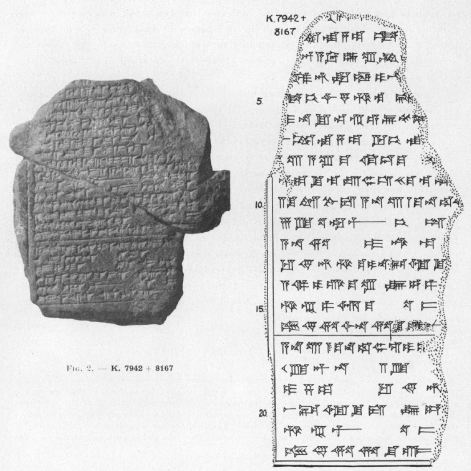
In 290 AD, Emperor Diocletian ordered the destruction of all manuscripts in the economic crisis-stricken empire on the topic of alchemy. Two manuscripts from Egypt written in Greek survived, and these papyri make it easy to understand why:
Several of the recipes speak quite explicitly about the economic purpose of these processes. Such phrases occur as e.g. “(alloy) imitating silver* of such a kind that it cannot be found out”, “this will be… of the first quality which will deceive even the artisans”, or “the metal will be equal to true… so much as to deceive even the artisans”.[13]
* Rome’s traditional metal currency (silver dēnārius)
By the early 14th century, the discovery of how to create highly corrosive acids had placed new weapons in the alchemists’ armoury. The need for secrecy was now being met through a complex array of cryptic allegories, symbols, euphemisms, and double, triple, or even greater multiple (Orwell’s doubleplus?) entendres:
Luna [☽ silver] is also yellowed similarly with a solution of Mars [♂ iron]. The method of that yellowing which is perfected by vitriol [🜖 sulphuric acid] or copperas [🜨 green vitriol] is as follows… Then it should be dissolved into a red water to which there is no equal.[14]
At the dawning of the Age of Reason, a recipe of the famous alchemist Basil Valentine – likely pseudonym of Johann Thölde, owner of a salt-works in Thüringia – offers us a glimpse of the “hidden” influence of alchemy on ‘modern’ systems of thought … and banking practice:
..in the bottom of the glass you will find the treasure, and fundamentals of all the Philosophers, and yet known to few, which is a red Oil, as ponderous in weight, as ever any Lead, or Gold may be, as thick as blood, of a burnt fiery quality.[15]

Book of Abraham Lambspring – Nicolaum Maium 1607
The sleeping Father is here changed
Entirely into limpid water,
And by virtue of this water alone
The good work is accomplished.
(Note the “hidden hand” (left), and the right hand making the sign of the 21st Hebrew letter, ש shin (šīn). It stands for Shaddai, a name for God. In the Sefer Yetzirah this “Mother Letter” means King over Fire: “He Made Shin King Over Fire, And He Tied A Crown To It” .. “the hissing ש corresponds to the hissing fire”.)
Today, we are enslaved by what two Italian professors recently called “outright false accounting”:
Under current accounting practices, seigniorage is largely underappreciated, it is systematically concealed, and is not allocated to the income statement (where it naturally belongs), while it is recorded on the balance sheet under debt liabilities, thus originating outright false accounting.
If money is accounted as debt, instead of correctly being considered as equity of the issuing entities and wealth for the society using it, it inevitably introduces a deflationary bias in the economy…[16]
This trick is not new.
It is simply the ‘modern’, electronic, government-licensed version of the same trick that ‘smiths and alchemists have used for millennia, to extract a special kind of “rent” from the sovereign, and the public.
1610s, “a person’s wealth,” from Medieval Latin capitale “stock, property,” noun use of neuter of Latin capitalis “capital, chief, first”.
[The term capital] made its first appearance in medieval Latin as an adjective capitalis (from caput, head) modifying the word pars, to designate the principal sum of a money loan. The principal part of a loan was contrasted with the “usury” – later called interest – the payment made to the lender in addition to the return of the sum lent.[17]
The difference between the value of money (its “purchasing power”), and the cost to produce it, is called seigniorage. The word comes from Old French, meaning “right of the lord (seigneur) to mint money.”
Minted coins bear an image of the bust or head (capital) of the sovereign – the “lord” of the land – because he/she is the creator (issuer) and owner of the coins. In accounting terms, the coins are the equity of the lord.
And they brought Him a dēnārius [a day’s wage]. And Jesus said to them, “Whose likeness and inscription is this?” They said, “[The Emperor Tiberius] Caesar’s.” Then He said to them, “Then pay to Caesar the things that are Caesar’s; and to God the things that are God’s.”
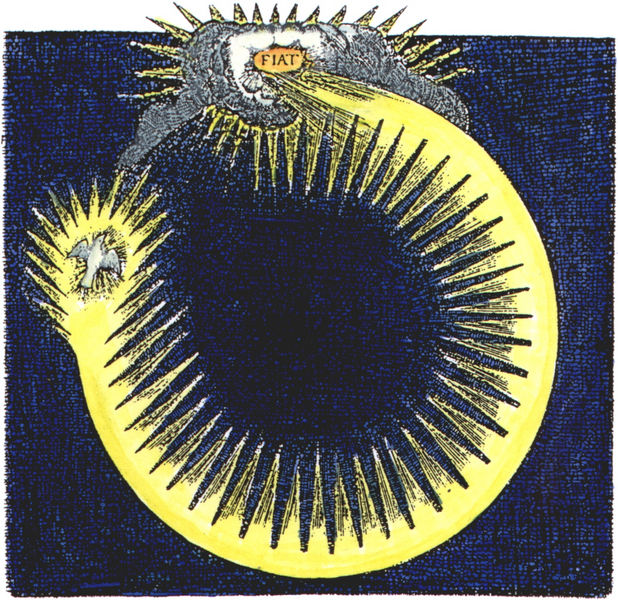
Robert Fludd, Utriusque Cosmi Maioris scilicet et Minoris Metaphysica Physica Atque Technica Historia, 1617-1621. © Adam McLean 1997-2017 (alchemywebsite.com). Used with permission.
The lord ‘issues’ new currency into the community, by using it to purchase something of value from his/her subjects. No matter what substance it is made from – no matter what its real value, in any other context – the coin’s face (“nominal”: named) value, and the requirement to accept it in payment, is decreed by the authoritative Word of the “Lord” (“fiat”):
Legal tender is any official medium of payment recognized by law that can be used to extinguish a public or private debt, or meet a financial obligation. The national currency is legal tender in practically every country. [..] A check, or a credit swipe, is therefore not legal tender; it merely represents a means by which the holder of the check can eventually receive legal tender for the debt.[18]
Even though the citizens now hold the coin, and use it as currency between themselves, the “Lord” still owns it, and may demand its return at any time, (e.g.), in payment of a tax ‘obligation’ (debt).
In effect, at any moment in time, a citizen and the “Lord” both claim to own the coin. And we know what happens when someone tries to fight the will of the “Lord”.
If that seems rather unjust to you – even tyrannical – then you are not alone.
Nicole Oresme (1320-1382) was one of the first medieval theorists who did not accept the right of the monarch to have claims on all money. Standard excuses, such as a “budget emergency”, did not hold water (pun intended) with Oresme. He stated that any ruler who reclaims monies they have previously issued (spent) is a “Tyrant dominating slaves.”[19]
In the Middle Ages, when commodity (metallic) money was standard, seigniorage was a tax added on to the cost of producing coins by the mints. A customer (e.g., a prince or feudal lord) who wished to issue coinage for trade within their own feudom or “fief” paid this tax, often in the form of a percentage of the metal delivered to the mint for coining, which was then passed on to the sovereign (king, queen) of the land.
Today, the ‘sovereign’ government ‘earns’ seigniorage profits in a similarly circuitous manner. Its profits are routed – pun intended – via the “independent” Central Bank:
In Canada today, seigniorage can be calculated as the difference between the interest the Bank of Canada earns on a portfolio of Government of Canada securities—in which it invests the total value of all bank notes in circulation—and the cost of issuing, distributing, and replacing those notes.
After deducting the Bank’s general operating expenses .. the remainder is paid to the Receiver General for Canada.[20]
In the case of the U.S. Federal Reserve System, its twelve Member banks are owned by private banks. The Fed pays a ‘return’ (dividend) of up to 6%[21] to those banks, before returning its leftover profits to the U.S. Treasury:
[T]he Reserve Banks are required by law to transfer net earnings to the U.S. Treasury, after providing for all necessary expenses of the Reserve Banks, legally required dividend payments, and maintaining a limited balance in a surplus fund.[22]
The Private Banking System also ‘earns’ a form of seigniorage profit or rent, called “monetary seigniorage”. It earns this on 97% of the ‘money’ supply. It is the difference between what it costs to produce their fictitious ‘deposits’ (i.e, nothing), and the interest and fees that we pay them for the use of what is actually our own money:
Commercial bank seigniorage represents structural element of subtraction of net real resources from the economy, with potentially deflationary effects on profits and/or wages, distributional consequences, and frictions between capital and labor.. .[23]
Perhaps it is now becoming evident why bankers see themselves as “doing god’s work”. They have succeeded in becoming gods of the earth. It is they who now create and issue the ‘currency’ we all use. They can and do demand its “return” – pun intended – as and when it suits them; typically, in a “liquidity crisis”. Having long ago usurped the powers of sovereigns, replacing them with an illusory rule of the dēmos (people), it is they who now ‘earn’ the vast majority of seigniorage profits from ‘money’ creation.
Thanks to the sleight of hand and mouth of the alchemists – hidden (“occult”) knowledge, that has been passed down for millennia in sexual allegories and symbols – the global money system is a cunning inversion (or reversal) of sovereign ownership rights.
We the People are, individually, the true seigneurs.
We – not bankers – are the true creators, issuers, and owners of the purchasing power (re-presented by “money”) used in the economy.
Through word ‘magic’ – especially puns; double entendres – and the paradoxical doublethink embedded in Double Entry Bookkeeping, bankers transform our wealth (equity) into debt.
Through this trick, they are able to ‘earn’ (steal) vast wealth and power for themselves.
Bankers have transformed themselves into the new Lords of Time. Their business is buying and selling our life times.
The business of banking can be – and indeed, has long been – defined as a ‘satanic’ practice. According to one of the founders of humanistic psychology, David Bakan:
A major psychological feature of black magic is that it provides immediate gains without immediate payment. The payment is feared as “really” both deferred and excessive. Thus deferred and excessive payment for immediate gain is characteristically associated with pacts with the Devil. The aversion towards usury, in current times as well as throughout the history of Christianity, is not completely coincidental. For usury is exactly a social expression of the Satanic Pact, immediate gains and excessive deferred payment.[24]
We ‘sell’ (promise) our future life energies to the bank, in exchange for a fictitious, lump sum ‘deposit’, or high usury ‘credit line’, now.
The bank ‘earns’ a covenanted flow of income from our labour, provided that we remain willing and able to pay, and, so long as the ‘sovereign’ remains willing and able to enforce the bank’s right to seize our real world assets pledged as collateral.
Over the long term, banks slowly acquire legal ownership title to all of our value-able assets, using their fictitious ‘loans’. The price of value-able assets is first driven up, thanks to the immediate availability of abundant, lump sum purchasing power, created by banks with a few keystrokes. Then, their price falls again, when the flow of new purchasing power ‘dries up’. Those who bought at the higher prices, are trapped paying usury on the ‘loan’ taken at the higher price. They have just been “fleeced”. Not just of ‘money’. They have been fleeced of the most precious ‘commodity’ of all .. life time.
Like the ‘loans’ themselves, the so-called “business cycle” is consciously, willfully, artificially created, by bankers, for the benefit of bankers.
–––––––– SIDEBAR ––––––––
Das guldene Vleiss (“The Golden Fleece”)
Alchimiæ encomium. Vera chymia licet mundo sapientia falsa,
attamen est divæ diva parens sophiæ.

Note hands *and* feet: Wealth, Assets (left); Double Entry book debt, Liabilities (right) | J.A. Siebmacher, Das guldene Vleiss (“The Golden Fleece”), Nurnberg, 1737. © Adam McLean 1997-2017 (alchemywebsite.com). Used with permission.
This 1737 alchemical text purports to show an image, dated to 1607, of ‘Sophia’ (Greek: σοφία), symbol of Wisdom in Hellenistic, Gnostic and Platonic philosophy and religion. In Orthodox and Roman Catholic Christianity, Holy Wisdom (Hagia Sophia) is an expression for God the Mother in the Trinity (Θεοτόκος, Theotokos), and often for the Holy Spirit, or Divine Logos, as personification of Christ.
What is depicted, however, is the alchemists’ androgyne god Hermes, or Mercury ☿ , as evidenced by his traditional symbol, the winged helmet. About his head, a nimbus of ‘light’. Around his neck, a pendant in the shape of a ‘heart’, womb, or ‘Water’ 🜄. The wealth in his left (Asset) hand, is the symbol of Venus ♀ (Female, Love, Beauty, Nature, Nurture), inverted, and bound; around the cross is a crown of thorns. On the left (Asset) wrist, a chain, from which a lamb is hanging. At his left foot, a pot of money, and treasure chest. Chained to his right (Liability) ankle, a ball with Mercury’s (“equal and opposite”) ‘wings’, adjacent alchemist’s flasks. ‘His’ robe exposes a female breast. There are twelve decorations on the hem; it is prominently secured at the top of ‘his’ thigh with one more decoration, a 4-petalled ‘flower‘ (🝊 wax, created by ‘drones’, labouring for a ‘Queen’, from whence golden ‘honey’; also 🜨 green vitriol), for a total of thirteen (number of lunar-menstrual cycles per year). In his right hand, a book opened, with an ‘eye’ on the left and right pages, and a serpent coiled around his arm.
The inverted and bound Venus, or orb and cross 🜭 , is the globus cruciger (Latin: “cross-bearing orb”), used from the early 5th century to represent Christ’s dominion over the world. In alchemy however, it is a symbol for cinnabar, or Mercury Sulphide. This is the source of two out of the three primary elements in alchemical ‘experiments’, and philosophy: the double-natured liquid-metal, Mercury ☿ (the “Divine Fiery Water” of Kabbalah), and Sulphur 🜍. The third element, is ‘Salt’ 🜔. Of the Earth 🜃. “The Body”. The ‘Base’ Matter. That must be subjected to Putrefaction 🝤. Reduced to a massa confusa (“confused mass”). Ringing bells? Look closely, at all the symbols. What do you see? Cinnabar 🜭 is also represented by 🜓 , a symbol of great significance (e.g., associated with Jesus’ life span; number of years between natural alignments of the pure lunar calendar and pure solar calendar.)
–––––––– END SIDEBAR ––––––––
There are other grave problems caused by bankers’ quest for profit. Making excessive new purchasing power available for consumption, and that of an increasingly vast array of products manufactured with a profit-driven goal of ‘Planned Obsolescence’ – i.e., poor quality – has dramatically accelerated humanity’s consumption of natural (and often, finite) resources.
This accelerated rate of production and consumption has, in turn, accelerated the production of waste, and pollution of the natural environment. While Mother Nature has her ways of recovering and restoring herself, it can take tens, hundreds, or hundreds of thousands of years for her self-healing processes – driven by her grateful receiving of energy from the Sun – to return Nature to anything like her former condition.
Allowing bankers to usurp our rights, as the seigneurs of our own money, and lords of the expenditure of our life’s time and energy, has not turned out well for many of us.
Even if we accept the narrow argument that capital-ism has “lifted millions out of poverty”, the manner and speed at which this has been achieved has not turned out well for our collective home – Mother Nature.
USURY
Sometimes, lest worse befall and to avoid scandal, a community tolerates dishonorable and evil things, like brothels. Sometimes also, by necessity or convenience, vile business is tolerated, like money-changing, or evil business, like usury.
Nicole Oresme (1320-1382 AD) [25]
Perhaps it is not an accident that the race which did most to bring the promise of immortality into the heart and essence of our religions has also done most for the principle of compound interest and particularly loves this most purposive of human institutions.
I see us free, therefore, to return to some of the most sure and certain principles of religion and traditional virtue – that avarice is a vice, that the exaction of usury is a misdemeanour, and the love of money is detestable, that those walk most truly in the paths of virtue and sane wisdom who take least thought for the morrow. We shall once more value ends above means and prefer the good to the useful. We shall honour those who can teach us how to pluck the hour and the day virtuously and well, the delightful people who are capable of taking direct enjoyment in things, the lilies of the field who toil not, neither do they spin.
But beware! The time for all this is not yet. For at least another hundred years we must pretend to ourselves and to every one that fair is foul and foul is fair; for foul is useful and fair is not. Avarice and usury and precaution must be our gods for a little longer still.
John Maynard Keynes (1930) [26]
With the bankers’ system, our money becomes our debt, because we don’t spend it into existence; we ‘sell’ it to the bank, in return for a fictitious ‘loan’ from the bank, created out of nothing by the Word of the “lord”.
Instead of equity (wealth, purchasing power), our money is magically transformed into the exact opposite: our promise to re-pay the bank in the amount of their fictitious ‘loan’ … plus “interest” (usury).
On the other hand, the bank ‘deposit’ record created in our name is considered our loan to the bank, and the bank might pay us “interest” on it.
Unsurprisingly, the banks ‘earn’ a higher rate of usury on their Asset (our promise to pay them), than they pay on their Liability (their promise to pay us).
The difference in these rates is called the “Net Interest Margin” (NIM). It is key to how banks ‘earn’ so much ‘money’ in profit. It is the 24/7/365 reward for their hard labour, in taking our money, and then renting the use of their fictitious accounting ‘money’ back to us.
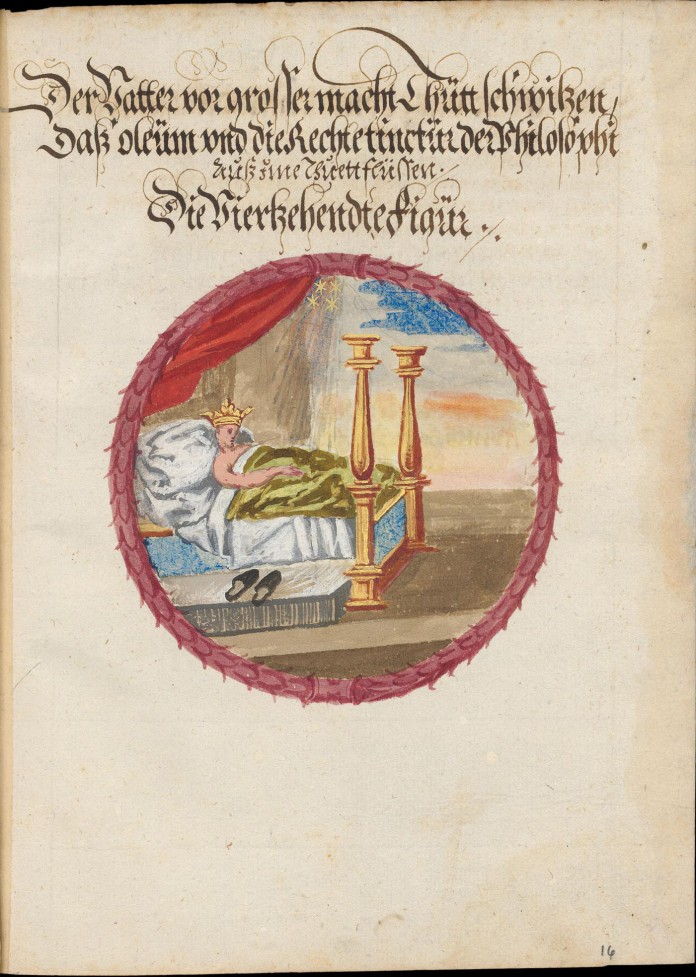
Book of Abraham Lambspring (1556)
I am told that the Danish, French, Germans and Italians do not use the words “Asset” and “Liability” as titles for Balance Sheet records. It would seem more than mere coincidence that they use their words for “Actives” and “Passives” instead.
How so?
In alchemy, the Active force is associated with the Male (Mars ♂, Fire), and the Passive with the Female (Venus ♀, Water).
copperas (n.)
A green, crystalline heptahydrate mineral of ferrous [iron] sulfate, FeSO4·7H2O. Also called green vitriol.
[Middle English coperose, a metallic sulfate, from Old French, from Medieval Latin cuperōsa, probably short for aqua cuprōsa, copper water, from Late Latin cuprum, copper]
French couperosé (adj., “blotchy”), from Latin cupri rosa, “rose of copper.”
Latin aes (“copper”) .. from the Latin form of the name of the island of Cyprus, where copper was mined (the alchemists associated copper with Venus).
Aes passed into Germanic .. and became English ore. In Latin, aes was the common word for “cash, coin, debt, wages” in many figurative expressions.

Roger Bacon (c. 1220-1292), from Michael Maier, Symbola aurea mensae, 1617. © Adam McLean 1997-2017 (alchemywebsite.com). Used with permission.
In the ‘modern’ money system, the Active (‘Male’) party is the bank. ‘He’ extracts usury from the Passive (‘Female’) party – the misled and deceived ‘borrower’.
Observe that even the usury that is ‘paid’ by the bank on its fictitious ‘deposits’, is recorded as if it were coming from the Passive (Liability, ‘Female’) side of its Balance Sheet.

Step-by-Step: How Banks Extract “Interest”
The fact is that from the earliest recorded times until the later Middle Ages even interest was forbidden by both canon and civil law, for interest then was synonymous with usury.
But the general detestation was diminished by 37 Hen. 8, c. 9 (1545) which, while entitled “A Bill Against Usury”, tacitly legalized it to a maximum of 10 per cent per annum. This statute inaugurated the serviceable fiction that usury no longer meant any interest, but only excessive interest.
The etymology of usury is from the Latin words usa and aera, meaning “the use of money”.
J.L. Bernstein, American Bar Association journal (1965) [27]
“Interest” (usury) is often called the “price” or “cost” of money. This cost is not just the price we pay for “the use of” the banks’ fictitious ‘deposits’. It is also a hidden cost, that is embedded in the prices of everything we buy.
Even those who imagine they have no debt, do, and are paying the price of someone else’s debt every time they go to a shop.
Indeed, even a ticket for “public” transport carries this hidden cost in its price.
Under this system, the bottom 80% of the population pay twice as much interest as they ‘earn’. The top 10% ‘earn’ twice as much interest as they pay. And the top 0.01% ‘earn’ 2000 times more interest than the top 10% receive, on average.

The interest usury system is the Number 1 driver of inequality.
Little has changed, in 5000 years.
Professor Michael Hudson (How Interest Rates Were Set, 2500 BC – 1000 AD) informs us that usury “became the major force polarizing ancient society as credit passed out of the hands of public institutions into those of private households”:
The irony is the fact that the Latin term for loan interest was fænus. Its prefix (fe‑) connoted the idea of fecundity, much as the Greek word for interest/usury, tokos [“birth”]. Aristotle noted that unlike cows which reproduce themselves, metallic money lent out by usurers is sterile. This barrenness of metal is the central problem of usury: Interest is demanded on the basis of money-loans whose proceeds are not invested productively, much less at sufficient profit to pay the rates demanded by usurers. [..]
Creditors often broke up families by taking away their servant girls, daughters, sons or mother as debt pledges, while they themselves refrained from marrying in order to keep their own family fortunes intact. [..]
By classical Greek and Roman times, no palace rulers were left to cancel agrarian debts and otherwise keep creditor power in check. Thus, what seems to have begun as justifiable debt in third‑millennium Mesopotamia evolved into classical usury. Its corrosive dynamics polarized ancient society more than any other factor, destroying the archaic social balance between rich and poor, mercantile creditors and cultivators, despite the nominal decline in interest rates.
The power of creditors increased in the face of declining royal authority. Although the normal lending rate declined from Bronze Age Mesopotamia through classical Greece and Rome, creditors were able to render irreversible the forfeiture of land and personal freedom which debtors traditionally had been obliged to pledge as a condition for obtaining loans. In sum, what is first documented in Sumer is a revolutionary institution, revolutionary in that interest-bearing debt ended up by inciting populations to revolution at the end of antiquity, in the second and first centuries BC throughout the Romanized Mediterranean world.[28]
–––––––– SIDEBAR ––––––––
The discovery of strong mineral acids, particularly of HNO3, and aqua regia, had a strong effect on existing ideas about minerals, metals, and their chemical composition. For example, the discovery of aqua regia [“royal water”, 🜆] derived from vitriol* and sal ammoniac [🜹] robbed gold of its status as an indestructible metal, for now it could be dissolved, or “killed” as some alchemists would say. .. Indeed, green vitriol was often referred to as “the green lion” [“devouring the Sun”] in alchemical terminology, and the corrosive elixirs extracted therefrom caused it to be the subject of much secrecy, allegory, and interesting imagery in fourteenth century alchemical texts.[29]
* green vitriol 🜨 (iron ♂ sulphate), and blue or “Roman” vitriol (copper ♀ sulphate)
–––––––– END SIDEBAR ––––––––
‘People’s revolutions’ rarely occurred under the monarchies of ancient Mesopotamia. Their kings gained favour with the commoners by regularly using their royal authority to declare the people’s debts forgiven. All private debts were cancelled, family members sold (bankrupted) into slavery were free to return home, and any property forfeited was returned to the original owner.
This practice involved smashing the clay tablets on which the details of debt were recorded. Typically this occurred at New Year, and so the people were able to start over with “a clean slate.”
In the series Mr Robot, the hacker hero Eliot wishes to destroy the digital records of student debt held by EvilCorp. In accounting terms he is attacking the asset side of a bank’s balance sheet – destroying the digital records of what people owe the bank – but the same process could be applied to the data records of bank liabilities, the promises they issue to people, the ‘money’ we see in our bank accounts.[30]
In Sumerian, it was called ama-gi; in Akkadian, andurārum; and in Babylonian, mi’arum. The word meant the return of persons or property to their origin, or former status.
Readers of my earlier essays on the radically misogynous, predatory sex ‘magick’ principles in alchemy and banking may recognise a profound significance, and connection, in learning that the Sumerian word ama-gi derives from a noun ama “mother”, and the present participle gi “return, restore, put back”. Its literal meaning is “return to the mother”.
The same word in Hebrew (דְּרוֹר֙) meant “release”, “a flowing”, and “liberty”.
From an unused root (meaning to move rapidly); freedom; hence, spontaneity of outflow, and so clear – liberty, pure.
It is the word Jesus is reported as using in his first public sermon, when he stood in the synagogue and read from the scroll of Isaiah:
The Spirit of the Lord is upon Me,
Because He has anointed Me to preach the good news to the poor.
He has sent Me to announce release (pardon, forgiveness) to the captives,
And recovery of sight to the blind,
To set free those who are oppressed,
to proclaim the favorable year of the Lord.
That word was deror.
DEROR
To radically shift regime behavior we must think clearly and boldly for if we have learned anything, it is that regimes do not want to be changed. We must think beyond those who have gone before us and discover technological changes that embolden us with ways to act in which our forebears could not.
Julian Assange (2006) [31]
If you think fundamentally, a banking licence is not given to everyone. It is only given to a certain organisation which fulfills certain criteria. So it’s a privileged licence.
Atul Shah (2018) [32]
A just system of currency has its foundation in equal rights. Equal rights are based on principles in harmony with the laws of nature.
John Whipple (1836) [33]
Imagine a world where you could do exactly what banks do.
Pay with “an electronic check drawn on (your)self.”
Imagine if everyone could do the same thing – “create a liability” on themselves, and use it to buy goods and services from each other.
A world with no banks, and no usury.
The accounting is really quite simple. We need only to cut the banks out of the picture we have just been looking at, and internalise the same operations.
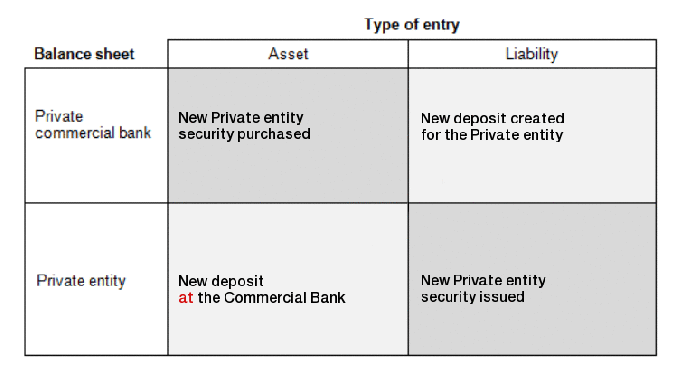
Imagine a world with no banks.
Unlike the banks, however, who “systematically conceal” the seigniorage value of the ‘deposits’ that they create out of nothing, cleverly taking that value for themselves (“seigniorage rent”), we will clearly show it, for everyone to see.
This can be done with an inverse public Honour rating, linked to both sides of your Balance Sheet.
In this accounting system, Single Entry is combined with Double Entry (SEDE). This means that most often, your “Balance Sheet” will not be balanced*. The amount on each side will be different. The side that is the largest determines your public Honour rating.
(* For readers keen on economic theory, this can be called a dynamic disequilibrium system.)
Let us see how it works.
Every time you draw a liability on yourself – that is, every time you create new purchasing power for yourself – your public Honour rating falls:

CREATE (Double Entry). © Colin McKay 2011-2018
In this step, you have not actually used your new purchasing power (‘money’) to pay for something yet. You have simply created a matching Asset and Liability. Exactly like all the banks do. And your public Honour rating fell, according to the amount you created. Anyone you trade with can now see that you have “drawn” a liability on yourself, of 5%. The seigniorage value of the new purchasing power that you just created for yourself, has been publicly recorded.
(So, if you didn’t actually need to buy something right now, perhaps you should have waited, until you do? That way, the seller would see your perfect public Honour rating, at the Point-Of-Sale.)
When you do buy something, however, only the Asset side of your Balance Sheet is effected. Part of your new Asset is transferred to someone else. But your public Honour rating remains unchanged:

SPEND (Single Entry). © Colin McKay 2011-2018
Why?
You created a debt (Liability), remember? In a real sense, that debt is not just a debt to yourself. Your creation of new purchasing power, out of nothing, bought you something (a benefit) that ultimately came from the natural world; consuming resources*, and/or human energy (life time). You need to give back – do something for someone else – to restore your public Honour.
(* Also, all human activities result in waste – pollution – in one or many forms. These real costs to the environment and society are “externalised” by current accounting methods. Some people profit – corporate ‘persons’. Everyone else suffers the costs.)
By selling something, or doing work for someone, you earn back purchasing power from others. Your debt (Liability) is reduced, and your public Honour rating rises.
In the following example, having spent 3000 (above), you are now receiving a payment of 2000, which cancels some of your Liability:
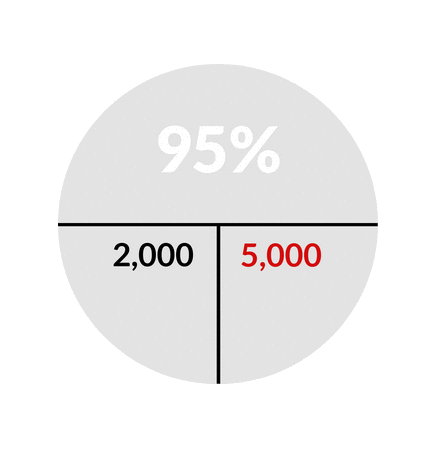
EARN (Single Entry). © Colin McKay 2011-2018
As you can see, when you received purchasing power (i.e., a payment) from someone else, only the Liability side was effected.
That is because any payments received are first used to reduce any outstanding Liability amount that you have previously created, by drawing on yourself.
If you have no Liability – a zero (0) on the right side – only then will new payments received be added to your Asset side.
In other words, you must pay down your Liabilities; you cannot just accrue more Assets. In time, your worsening public Honour will incline others to refuse to deal with you.
Remember: your public Honour rating is determined by the largest side of your Balance Sheet. This means that simply building up more accounting Assets also harms your Honour rating. If you have them, it is wiser to spend them, which benefits someone else, as well as yourself. After all, you can always create more, when and if you really need it. In this way you can maximise your public Honour.
If you wish, you can transfer amounts internally – from your Asset side to your Liability side – in order to more quickly restore your public Honour rating.
For example, perhaps you have created more purchasing power than you actually need to spend right now. You can simply transfer your Asset, to cancel out some (or all) of your Liability:

BALANCE (internal). © Colin McKay 2011-2018
This system is built on a set of rules that provide everyone with strong incentives to do the right thing. For themselves. For others. And for nature.
To use your seigniorage rights – that is, your individual sovereign right to create purchasing power – wisely, and sustainably.
By exercising self-discipline with your life’s time – by balancing your spending flow and your earning flow – you maximise your public Honour.
Alchemical symbol for Time (1 hour)
🝮
Alchemical symbol for Time (24 hours)
🝰
I-Ching, Hexagram 24 復 (fù): “Return”, The Turning Point, Renewal, Restore
![]()
Now, we all know that life can seem cruel at times. We make mistakes. And pay a price. Sooner, or later. Sometimes they are really big ones. And sometimes, despite our best efforts, things just happen to us.
We have accidents. We fall ill. Or someone we love does. The economy has a “downturn”. We lose our job. Our business fails. On it goes.
Many have tried to sell us the idea that “everyone is (born) equal” but let us be honest here, ok?
That is a plain, bald-faced lie.
For many, the ‘negative’ outcomes – at least compared to many others – begin before conception.
For some, extraordinarily ‘positive’ outcomes begin before conception.
I am confident, for example, that there are some who will read this essay – and many more who won’t – who are natural-born, genius intellects. Or at least, an awful lot smarter than I. And there are others, who are naturally gifted with an overabundance in particular drives, or aptitudes, and so will always be able to out-compete me, and you, in one way or another … and possibly in everything!
And that’s just fine by me. Personally, I cannot, and do not wish to imagine the bleak, colourless horror of a world without difference.
Frankly, I do not believe that mere imperfect humans are capable of conceiving a “perfect” system of exchange, that can ‘magically’ create a utopian outcome in a world of vast differences, and imperfections. To imagine that we can, I think, implies a degree of egotism that should encourage our caution.
I do believe, however, that after 5000 years of repeating exactly the same, fundamental mistakes when it comes to the design, and regulation of our mediums of exchange, that now we can design systems that are, at least, a lot more fair.
And, a lot more merciful.
This accounting system offers everybody exactly the same power to create purchasing power … coupled with exactly the same responsibilities.
So, it is only fair that it offers everybody the same amount of mercy.
And it gives this mercy – or grace – every week. Not once a year, or every seven, or forty-nine, or when a new king ascends the throne and wants to buy public favour.
Every seventh day, the algorithm cancels a percentage of the units from both sides of your Balance Sheet.
It restores your public Honour.
You might call it a small weekly Jubilee. Or andurārum, or mi’arum, or a return to the mother.
Or … grace. A little bit of forgiveness.
I call it Polarised Demurrage (“P.D.”).
It is a kind of “inverse” demurrage function, that operates the same way on both of the unequal and opposite “poles” of your Balance Sheet.
The following example illustrates how it works. To make it simpler (for me, to make the animation!), this only shows what P.D. will do with no new transactions by you, of any kind, over eight weeks.
Notice how both sides of your Balance Sheet reduce, and your public Honour rating climbs a little each week. It starts with you in the somewhat precarious position of only 60% Honour – because you are 40,000 in the red.
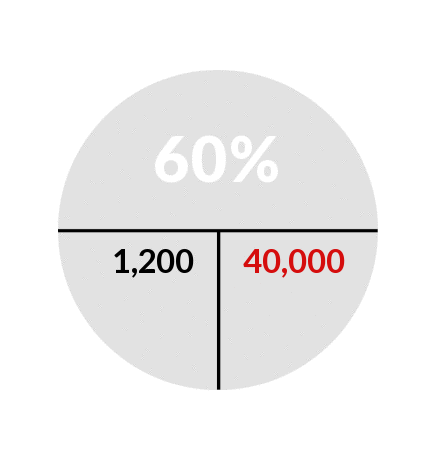
POLARISED DEMURRAGE™. © Colin McKay 2011-2018
Any time you receive a payment, or, spend some of your Assets, or, create some more purchasing power for yourself, the algorithm will simply recalculate, and start the weekly forgiveness cycle over again.
The seventh day – the day that you receive some forgiveness – is determined by the date of the transaction that has taken you the greatest distance away from zero .. on either side of your Balance Sheet. Your personal “forgiveness day” will only change, if you exceed that number again, on a different day of the week.
Here is one more example, to illustrate how a new drawing of liability on yourself interrupts, and restarts, your forgiveness cycle. Again, you are starting 40,000 in the red, at 60% Honour.
After four (4) weeks worth of “forgiveness”, during which time you have (again) not made any new transactions of any kind, you decide to draw some more liability on yourself – another 3000.
The forgiveness cycle is shown continuing on for a further six (6) weeks, after your new “drawing” of 3000.

POLARISED DEMURRAGE™ (with redraw after 4 weeks). © Colin McKay 2011-2018
I hope that this has helped to show you that it is possible for us to eliminate the role of banks, and usury.
That it is possible to create a new system of ‘money’ and exchange, that returns our seigneur right to ourselves, and works fairly and equally for everyone.
An inversion, of their inversions.
It is not even a ‘money’ system, really. It is just a system for counting how much net benefit each one of us has gained, from the equal right to make withdrawals from other people’s – and nature’s – finite resources.
I think that a counting system like this would eliminate many problems caused by the greed of the ‘smiths and alchemists, and, provide benefits similar to those that many are now calling for – e.g., UBI, “living wage” – without having to beg banker-owned ‘sovereign’ governments for it.
Or trust that they will not abuse the increased power such regimes would give them, over our life times.
Or trust that we will not fall into ever more destructive habits of mind and action, as a result of increased dependency, without increased responsibility.
Perhaps you might wish to think about the pros and cons of this system, for yourself.
In future, I will write more on how this new SEDE accounting system embodies principles of what some believe to be ‘sacred’ geometry, expressing the Grace (Mercy), Nurture, Wisdom and Beauty of the life-giving Female .. or Mother .. Nature.
******************
REFERENCES
[1] Galbraith, JK, Money: Whence It Came, Were It Went (1975), p. 15 – retrieved from Wikiquote August 2018
[2] McKay, Colin, deror.org, (2011)
[3] Becklumb, P., and Frigon, M., How the Bank of Canada Creates Money for the Federal Government: Operational and Legal Aspects (10 August 2015) – retrieved August 2018
[4] Nichols, D.M. and Gonczy, A.M.L, Modern Money Mechanics: A Workbook on Bank Reserves and Deposit Expansion (1994 edition), p. 6
[5] Investopedia: Promissory Notes – retrieved August 2018
[6] Financial Stability Board, Key Attributes of Effective Resolution Regimes for Financial Institutions (2014 revision) – retrieved August 2018
[7] Nichols, D.M. and Gonczy, A.M.L, Modern Money Mechanics: A Workbook on Bank Reserves and Deposit Expansion (1994 edition), p. 6
[8] Werner, R.A., A Lost Century in Economics: Three theories of banking and the Conclusive Evidence (2014)
[9] Angas, Major L.L.B. (Lawrence Lee Bazley), Slump ahead in bonds (1937), Somerset Pub. Co. pp. 20-21. (cited in Wikiquote, Banking) – retrieved August 2018
[10] Keynes, J.M., Newton, the Man, (c. 1946) – retrieved from University of St. Andrews History of Mathematics archive, August 2018
[11] King, L.W., The Code of Hammurabi, The Avalon Project, Yale Law School – retrieved August 2018
[12] Revue d’Assyriologie et d’archéologie orientale. Given intention to publish a book revealing further evidences, the author apologises for not providing a more detailed citation.
[13] ibid.
[14] Karpenko, V. and Norris, J.A., Vitriol in the History of Chemistry, Chem. Listy 96, 997-1005 (2002)
[15] ibid.
[16] Bossone, B. and Costa, M., Monies (Old and New) Through the Lens of Modern Accounting (2018), VOX CEPR – retrieved July 2018
[17] Fetter, F.A., Reformulation of the Concepts of Capital and Income in Economics and Accounting (1937) in “Capital, Interest, & Rent” (1977). via etymologyonline, Capital – retrieved August 2018
[18] Investopedia: Legal Tender – retrieved August 2018
[19] Oresme, N., Treatise on the Origin, Nature, Lw, and Alterations of Money (De origine, natura, jure et mutationibus monetarum), cited in Woodhouse, A. “Who Owns the Money?” Currency, Property, and Popular Sovereignty in Nicole Oresme’s De moneta (2017-18). Speculum. 92 (1): 85-116
[20] Bank of Canada, Backgrounders: Seigniorage, March 2013 (pdf) – retrieved August 2018
[21] Board of Governors of the Federal Reserve System, Federal Reserve Board issues interim final rule regarding dividend payments on Reserve Bank capital stock, Feb 18, 2016. – retrieved August 2018
[22] Board of Governors of the Federal Reserve System, FAQs – About the Fed: Who owns the Federal Reserve? – retrieved August 2018
[23] Bossone, B. and Costa, M., Monies (Old and New) Through the Lens of Modern Accounting (2018), VOX CEPR – retrieved July 2018
[24] Bakan, D., Sigmund Freud and the Jewish Mystical Tradition (1958). D. Van Nostrand Company Inc. New York. p. 204
[25] Oresme, N., cited in Rolnick, A.J., Velde, F.R., & Weber, W.E., The Debasement Puzzle: An Essay on Medieval Monetary History, Federal Rserve Bank of Minneapolis, Quarterly Review, Fall 1997 – retrieved August 2018 (pdf)
[26] Keynes, J.M., Economic Possibilities for our Grandchildren: Essays In Persuasion, The Future (1930) – retrieved September 2017
[27] Bernstein, J.L., The Checkered Career of Usury, American Bar Association Journal, Volume 51, September 1965. – retrieved August 2018
[28] Hudson, M., How Interest Rates Were Set: 2500 BC – 1000 AD (2000) – retrieved August 2018
[29] Karpenko, V. and Norris, J.A., Vitriol in the History of Chemistry, Chem. Listy 96, 997-1005 (2002)
[30] Scott, B., How to Burn Digital Money, 1 August 2018 – retrieved August 2018
[31] Assange, J., Conspiracy as Governance (2006) – retrieved Augsut 2018 (pdf)
[32] Shah, A.K., Big Four and the Revolving Door, Renegade Inc (2018) – watch online
[33] Whipple. J., The Importance of Usury Laws (1836)



